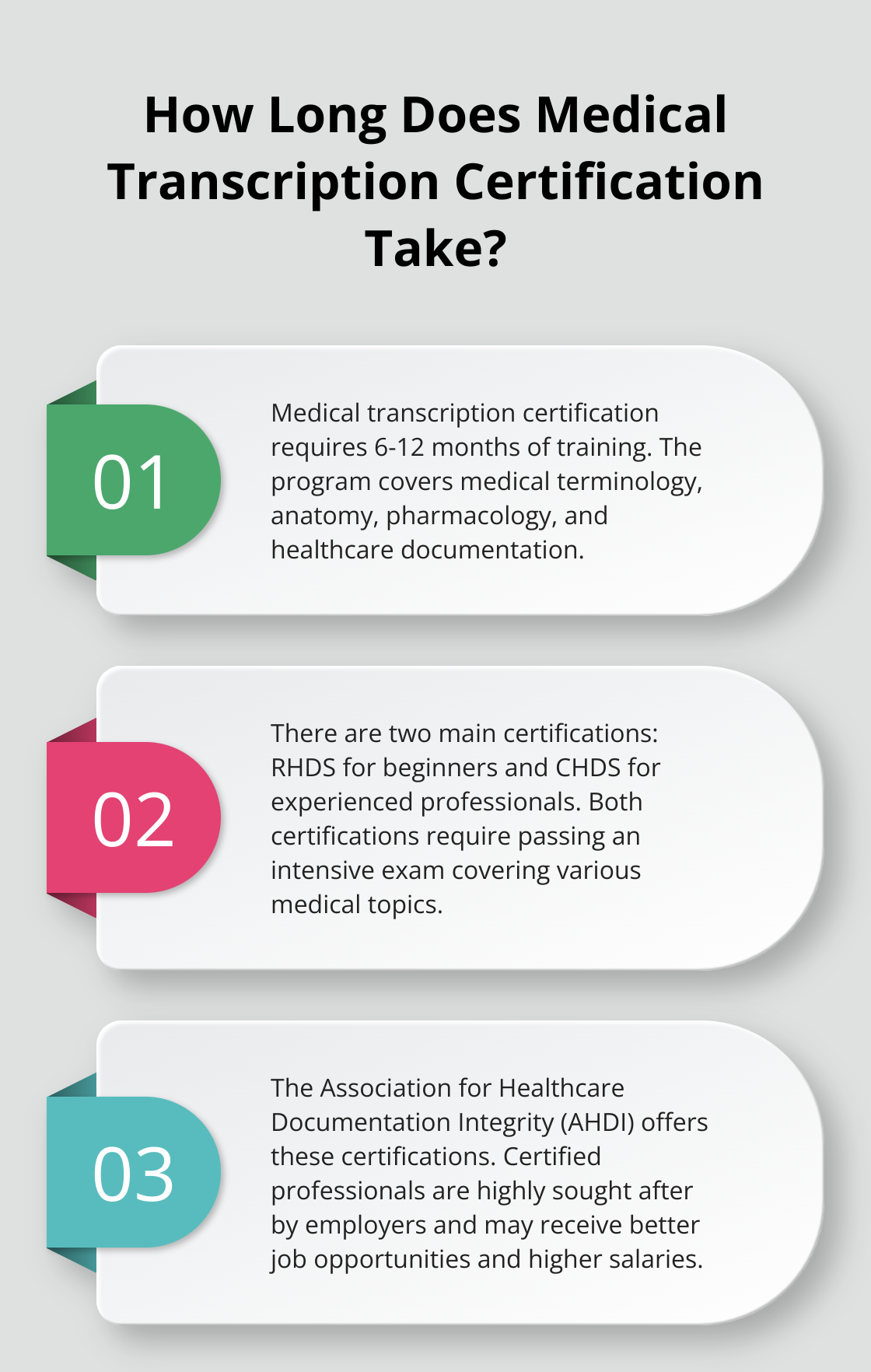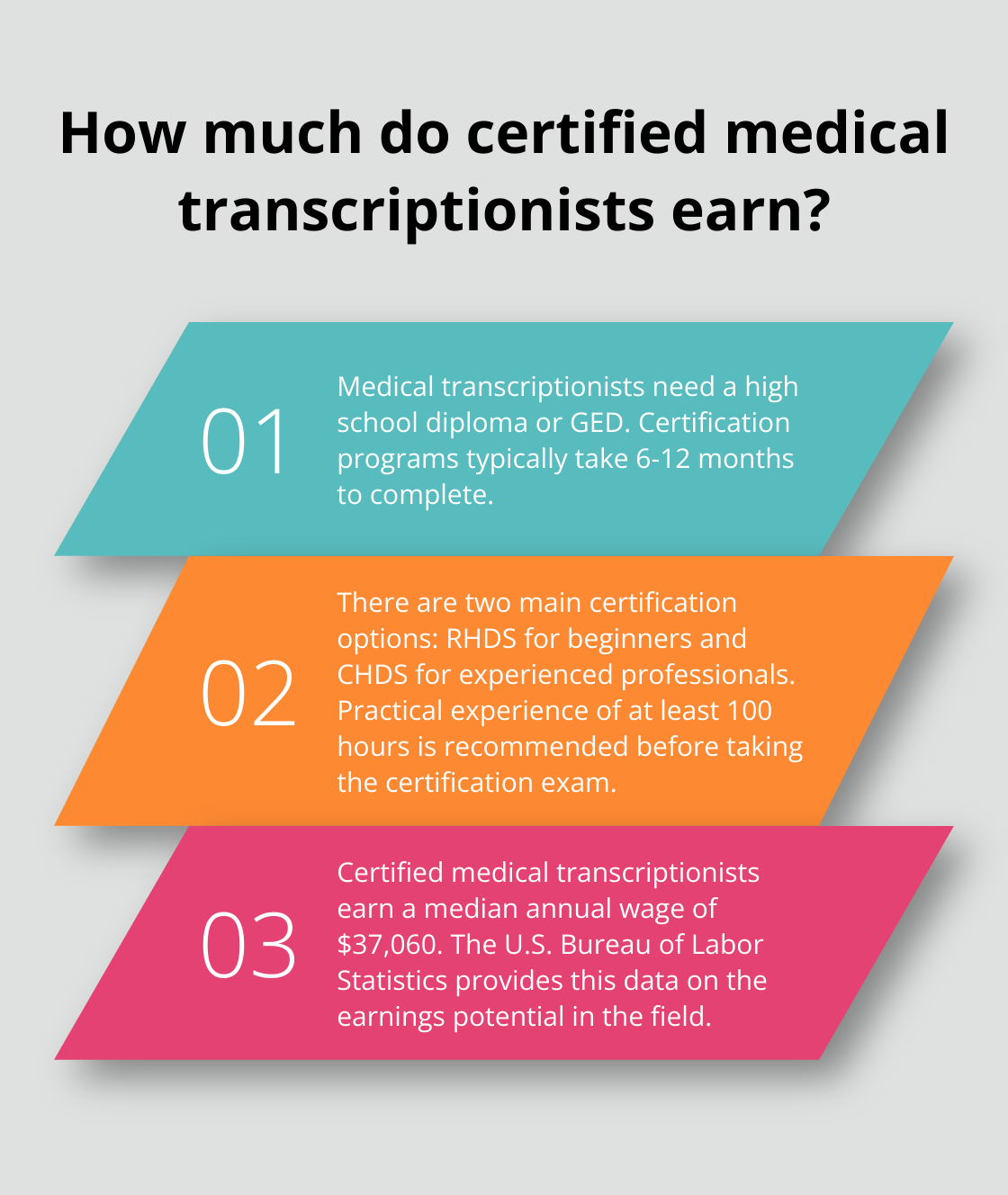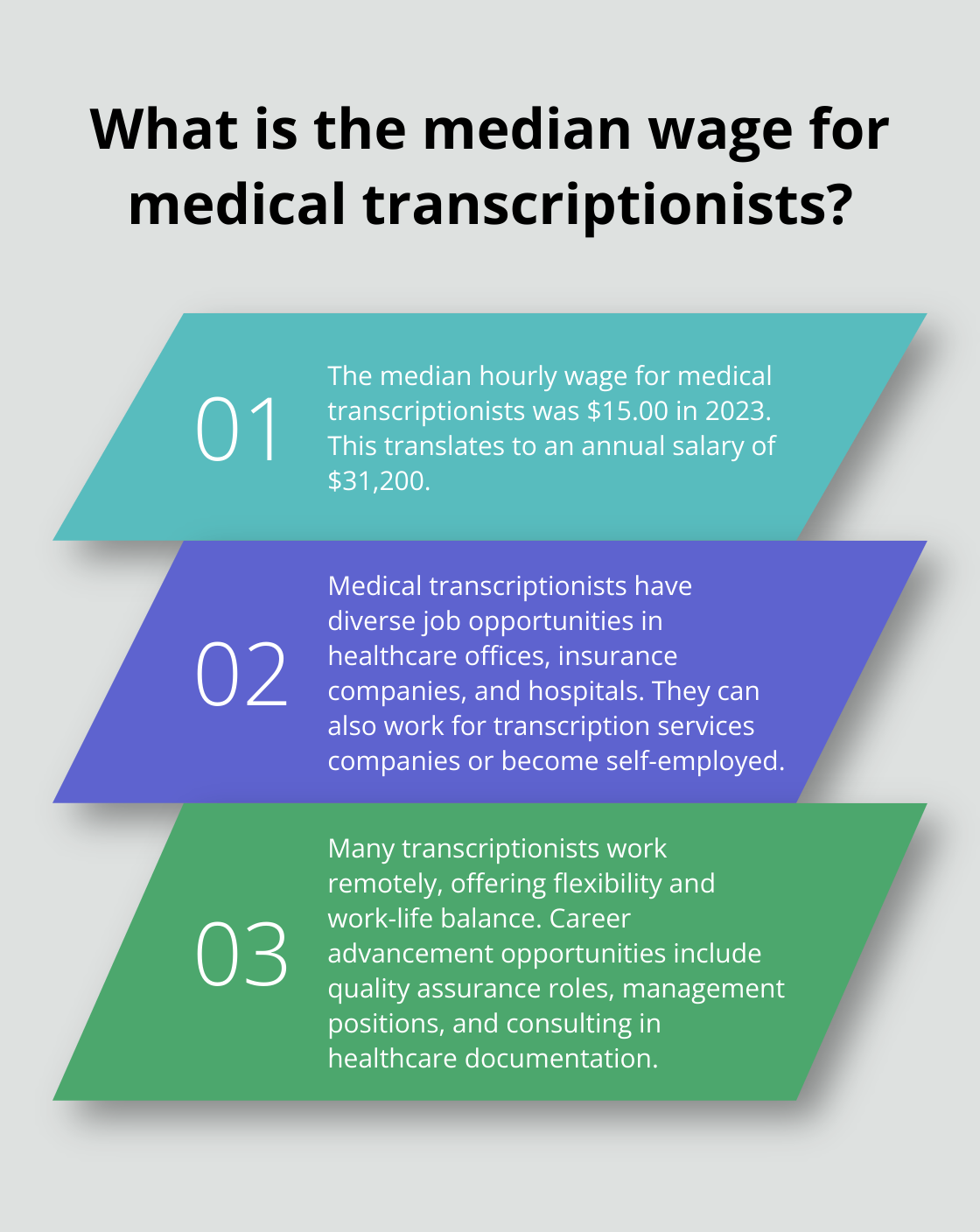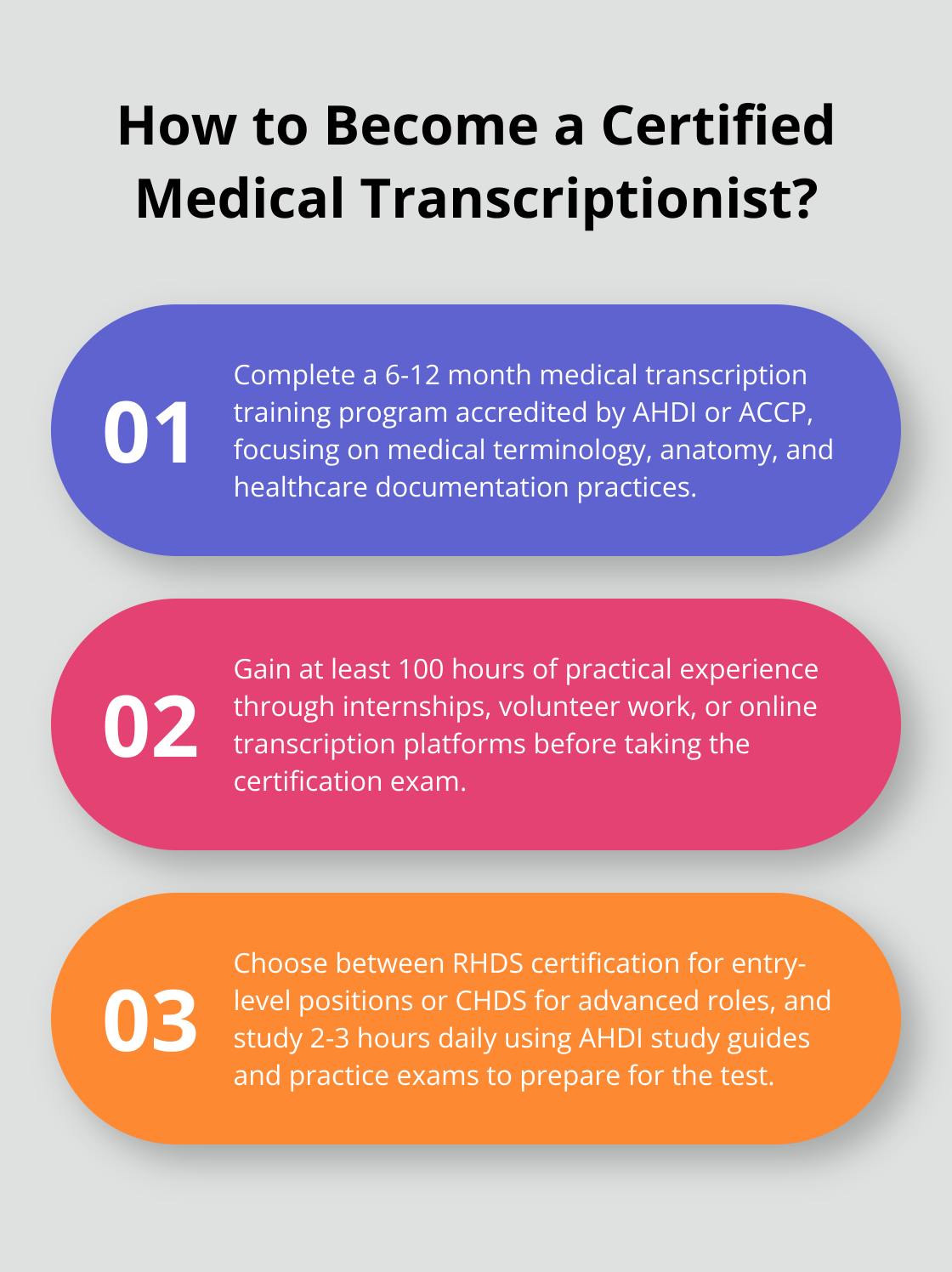Medical transcription certification—what’s the scoop? It’s a nifty credential that’s got some serious pull in the healthcare game. It shows you’ve got the chops to nail down those medical records and reports.
At ScriberJoy, we’re hip to what this certification can do for you—boost your career, snag those job ops, you name it. So, what are we doing here? We’re giving you the lowdown on how to grab that medical transcription certification. Plus, we’ll toss in a peek at the career doors it’ll swing open for you… all in one tidy guide.
What Is Medical Transcription Certification?
Definition and Importance
Medical transcription certification-what’s the deal with it? It’s more than just a fancy piece of paper; it’s a badge that says, “Hey, I can turn those audio-recorded medical ramblings into crystal-clear written reports.” We’re talking about being the DJ of medical words, mixing terms that even Google might struggle with. You’re the maestro of healthcare documentation, keeping patient secrets like Fort Knox. So, why does it matter? In healthcare, precision is everything. A comma out of place or a drug name whispered incorrectly? Boom, it could lead to chaos. That’s why having that certification is like having a golden ticket. It screams to employers that you’re the real deal-trained to juggle that sensitive info without dropping the ball.

The Association for Healthcare Documentation Integrity (AHDI) knows what’s up. They say certified pros are the ones employers are scouting for. It’s your ticket to not just jobs, but generously packed paychecks. Some places won’t even look at you without it, especially if you’re eyeing a promotion.
Types of Certifications
AHDI lays out two gold stars for the ambitious:
- Registered Healthcare Documentation Specialist (RHDS): Think of this as your entry pass. Perfect for newbies or folks who haven’t yet clocked two years in the hustle and bustle of acute care.
- Certified Healthcare Documentation Specialist (CHDS): This one’s for the vets. You need to have two solid years of acute care-or the RHDS badge-to stroll up and claim this advanced title.
Each of these requires you to ace an intensive exam, packed with questions on medical lingo, anatomy, physiology, and the art of healthcare documentation. It’s no walk in the park, but it’s how you earn your stripes.
Preparation Process
Okay, so you wanna get certified? You gotta walk the walk by enrolling in a medical transcription training program. Usually, you’re looking at 6-12 months of diving deep into medical terms, anatomy, pharmacology-the whole shebang. Getting that certification isn’t just homework; it’s an investment in you. It says you’re serious about this path, and it opens doors to better gigs and more cash.
The Role of Technology
Sure, tech like ScribeJoy speeds things up-makes the transcription treadmill a little less grueling. But the magic really happens when certified pros step in. They ensure the final product is as accurate and high-quality as it can be. Together, tech and skilled humans? That’s dynamic duo territory for healthcare docs.
As we roll on, let’s break down the steps to snagging your medical transcription certification and kicking off a career in this ever-evolving, always-exciting field.
How to Get Your Medical Transcription Certification
Educational Foundation
Start your ride on this journey with a solid educational foundation-think high school diploma or GED. Most certification programs want to see one of those shiny certificates before you dive in. You gotta enroll in a medical transcription program-takes about 6-12 months. These programs cram your brain with all the good stuff: medical terminology, anatomy, pharmacology…and all those healthcare documentation practices nobody tells you about.

Pick programs that show off those accreditations by the Association for Healthcare Documentation Integrity (AHDI) or the Approval Committee for Certificate Programs (ACCP). That fancy stamp of approval means you’re getting edu-prepped for those certification exams.
Practical Experience
While you’re hitting the books, score some practical experience. Look out for training programs with internships or practicum opportunities-if yours doesn’t, no biggie, find volunteer gigs at local healthcare spots or online transcription platforms. Your mission? Transcribe actual medical dictations; get comfy with accents, specialties, report types-the whole shebang.
Aim for at least 100 hours of hands-on hustle before tackling your certification exam. This know-how will crank up your confidence…and boost those odds of passing.
Certification Options
AHDI’s got two main ways to slap a cert on your efforts:
- Registered Healthcare Documentation Specialist (RHDS): The rookie badge-good for recent grads or those with just under two years of acute care experience.
- Certified Healthcare Documentation Specialist (CHDS): The heavyweight-needs a couple of years in acute care motion (or the RHDS cert on your mantle already).
Pick what aligns with where you’re at-your experience level and career ambitions. RHDS? Great launchpad. CHDS? Unlocks fatter paychecks and management suits.
Effective Study Strategies
Got your certification pick? Lock and load on a focused study strategy. The AHDI hands out official study guides and practice exams-don’t snub ‘em. They mirror the real deal exam, giving you a taste of what’s coming.
Slam down a study schedule and stick to it. Keep 2-3 hours of serious study time on the daily agenda. Flashcards for med lingo, transcribing those audio files-join online forums or study groups to mingle with fellow transcription warriors.
Tech’s your friend here. Tools like ScribeJoy can drop you into a real-world transcription zone. They’re not a certification substitute but yes, they’ll hone your skills and tighten your efficiency.
The exam pops questions that test your practical application vibe, not just memory hoarding. Understand concepts, know their drills.
Stay centered on that end goal. The U.S. Bureau of Labor Statistics spills that certified medical transcriptionists make a median annual wage of $37,060 (not too shabby on that education and certification investment).
Suit up with prep and grit-you’ll soon slide into those ranks of certified medical transcriptionists. This challenging ride gets you a ticket to a rewarding career in healthcare documentation. Next up, unveiling the array of thrilling career paths awaiting with that medical transcription certification of yours.
What Career Paths Open Up With Medical Transcription Certification?
Medical transcription certification-it’s not just a piece of paper. It’s your golden ticket to a realm of opportunities in healthcare documentation. Let’s dive into the thrilling career paths that unlock when you’ve got that certification in your pocket.
Diverse Job Roles and Responsibilities
So, you’re a certified medical transcriptionist? Welcome to the epicenter of healthcare documentation. Your job isn’t just typing away-it’s about translating voice-recorded reports into flawless documents. You’re like a medical codebreaker-unraveling jargon, catching the slips, and making sure every single detail is bang on.
Medical transcriptionists-they’ve got options galore. Work for healthcare offices, insurance companies, hospitals, or transcription services companies. Fancy being your own boss? Go for it. You might specialize in radiology, pathology, or cardiology. Each field tosses different challenges your way, keeping things spicy and fresh.
Work Settings and Employment Options
The best part of this gig? Flexibility. Many transcriptionists are dialing it in from home these days. The Association for Healthcare Documentation Integrity (AHDI) points out that remote work is all the rage here, serving up that sweet work-life balance.

Prefer the buzz of an office? You’re covered. Hospitals, clinics, and medical practices all hunt for sharp transcriptionists. Some even take the plunge into entrepreneurship, launching their own transcription shindigs.
Salary Expectations and Growth Potential
Now, let’s talk dough. According to the U.S. Bureau of Labor Statistics, the median hourly wage for medical transcriptionists was $15.00 in 2023, stacking up to an annual haul of $31,200.
Your paycheck? It tends to grow as your experience and niche grow. Specialize in complex fields or nab a supervisory role, and you’ll see those numbers climb.
Career Advancement Opportunities
Certification is your door to moving up. Many certified transcriptionists slide into quality assurance gigs-fine-tuning the work of others. Some steer into management, leading transcription teams in major healthcare setups.
Some even use their chops to train or consult, helping healthcare outfits streamline their documentation groove. The talents you polish as a certified transcriptionist? They’re gold for other healthcare documentation roles, like medical coding or health info management.
Adapting to Technological Changes
Alright, sure, the Bureau of Labor Statistics says traditional transcription roles might dip thanks to tech leaps. But hey, don’t let that rain on your parade. The healthcare sector still cherishes the human touch to nail accuracy and context. Tools like ScribeJoy pump up efficiency, but they hit their stride with sharp, certified pros like you at the helm.
Your certification? It’s a badge of honor in this field. It tells potential employers you’re prepped to tackle the intricacies of medical documentation with flair and finesse. As healthcare keeps evolving, certified pros who can roll with the punches and grow alongside the industry will always steal the spotlight.
Final Thoughts
Medical transcription certification – it’s your badge of credibility in the healthcare jungle. What’s it do? It says, “I’m legit.” Boosts your bank account, too – higher paycheck, more job security. But don’t think it’s a walk in the park. You need a rock-solid education, hands-on know-how, and some serious prep for that exam.

Here’s the kicker: despite all the tech wizardry, the healthcare sector still craves the human touch for nailing accuracy and context in medical records. Sure, tools like ScribeJoy are nifty – AI doing the heavy lifting, but with a human-proofreader chaser. The result? Spot-on medical records, freeing up the docs to do what they do best – doctoring.
Grabbing that certification isn’t just a win – it’s a gateway to a smorgasbord of opportunities in healthcare documentation and beyond. It outfits you with the smarts and skills to go the distance in this vital field. As healthcare morphs and grows, certified transcriptionists? They’re like the bedrock – ensuring those medical records stay up to snuff.

Leave a Reply
You must be logged in to post a comment.